Accounting Theory and Current Issues
VerifiedAdded on 2023/04/21
|18
|4448
|392
AI Summary
This report discusses accounting theories and their application in major accounting issues. It analyzes the qualitative characteristics of financial reporting, the decision to amend Corporations Act, asset revaluation motivations, and the impact of lease standards on financial reporting.
Contribute Materials
Your contribution can guide someone’s learning journey. Share your
documents today.

Running head: ACCOUNTING THEORY AND CURRENT ISSUES
Accounting Theory and Current Issues
Name of the Student
Name of the University
Author’s Note
Accounting Theory and Current Issues
Name of the Student
Name of the University
Author’s Note
Secure Best Marks with AI Grader
Need help grading? Try our AI Grader for instant feedback on your assignments.
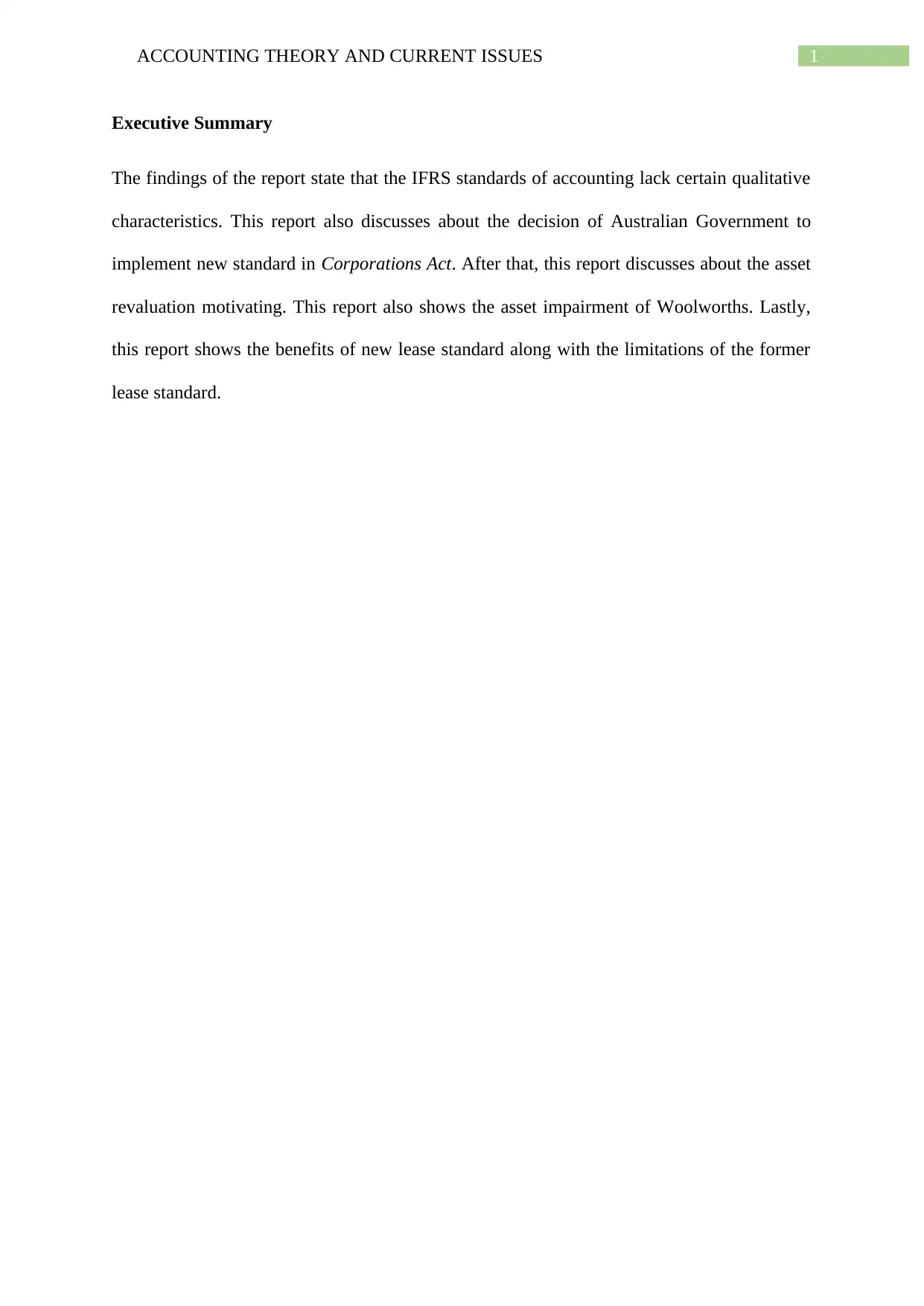
1ACCOUNTING THEORY AND CURRENT ISSUES
Executive Summary
The findings of the report state that the IFRS standards of accounting lack certain qualitative
characteristics. This report also discusses about the decision of Australian Government to
implement new standard in Corporations Act. After that, this report discusses about the asset
revaluation motivating. This report also shows the asset impairment of Woolworths. Lastly,
this report shows the benefits of new lease standard along with the limitations of the former
lease standard.
Executive Summary
The findings of the report state that the IFRS standards of accounting lack certain qualitative
characteristics. This report also discusses about the decision of Australian Government to
implement new standard in Corporations Act. After that, this report discusses about the asset
revaluation motivating. This report also shows the asset impairment of Woolworths. Lastly,
this report shows the benefits of new lease standard along with the limitations of the former
lease standard.
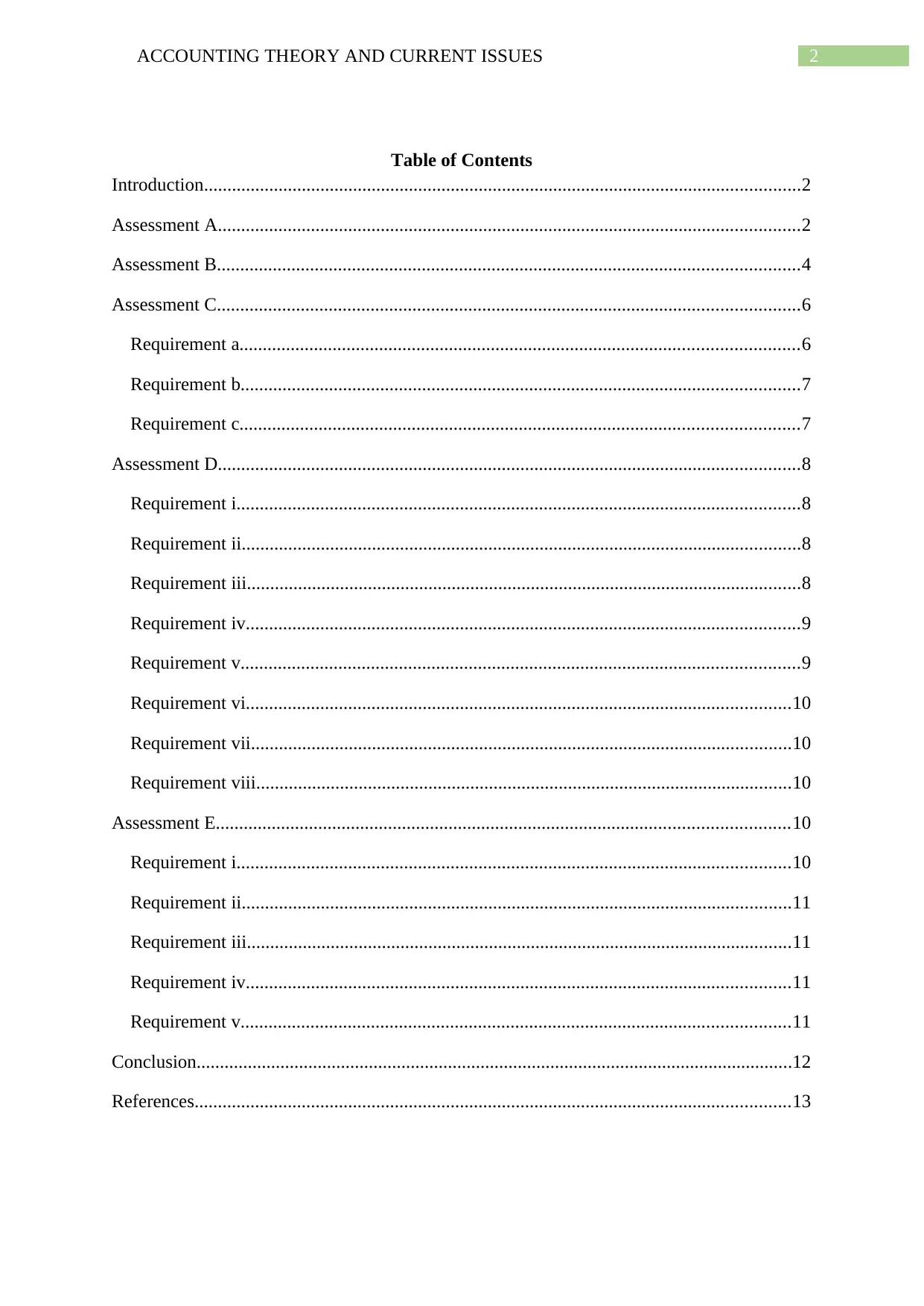
2ACCOUNTING THEORY AND CURRENT ISSUES
Table of Contents
Introduction................................................................................................................................2
Assessment A.............................................................................................................................2
Assessment B.............................................................................................................................4
Assessment C.............................................................................................................................6
Requirement a........................................................................................................................6
Requirement b........................................................................................................................7
Requirement c........................................................................................................................7
Assessment D.............................................................................................................................8
Requirement i.........................................................................................................................8
Requirement ii........................................................................................................................8
Requirement iii.......................................................................................................................8
Requirement iv.......................................................................................................................9
Requirement v........................................................................................................................9
Requirement vi.....................................................................................................................10
Requirement vii....................................................................................................................10
Requirement viii...................................................................................................................10
Assessment E...........................................................................................................................10
Requirement i.......................................................................................................................10
Requirement ii......................................................................................................................11
Requirement iii.....................................................................................................................11
Requirement iv.....................................................................................................................11
Requirement v......................................................................................................................11
Conclusion................................................................................................................................12
References................................................................................................................................13
Table of Contents
Introduction................................................................................................................................2
Assessment A.............................................................................................................................2
Assessment B.............................................................................................................................4
Assessment C.............................................................................................................................6
Requirement a........................................................................................................................6
Requirement b........................................................................................................................7
Requirement c........................................................................................................................7
Assessment D.............................................................................................................................8
Requirement i.........................................................................................................................8
Requirement ii........................................................................................................................8
Requirement iii.......................................................................................................................8
Requirement iv.......................................................................................................................9
Requirement v........................................................................................................................9
Requirement vi.....................................................................................................................10
Requirement vii....................................................................................................................10
Requirement viii...................................................................................................................10
Assessment E...........................................................................................................................10
Requirement i.......................................................................................................................10
Requirement ii......................................................................................................................11
Requirement iii.....................................................................................................................11
Requirement iv.....................................................................................................................11
Requirement v......................................................................................................................11
Conclusion................................................................................................................................12
References................................................................................................................................13
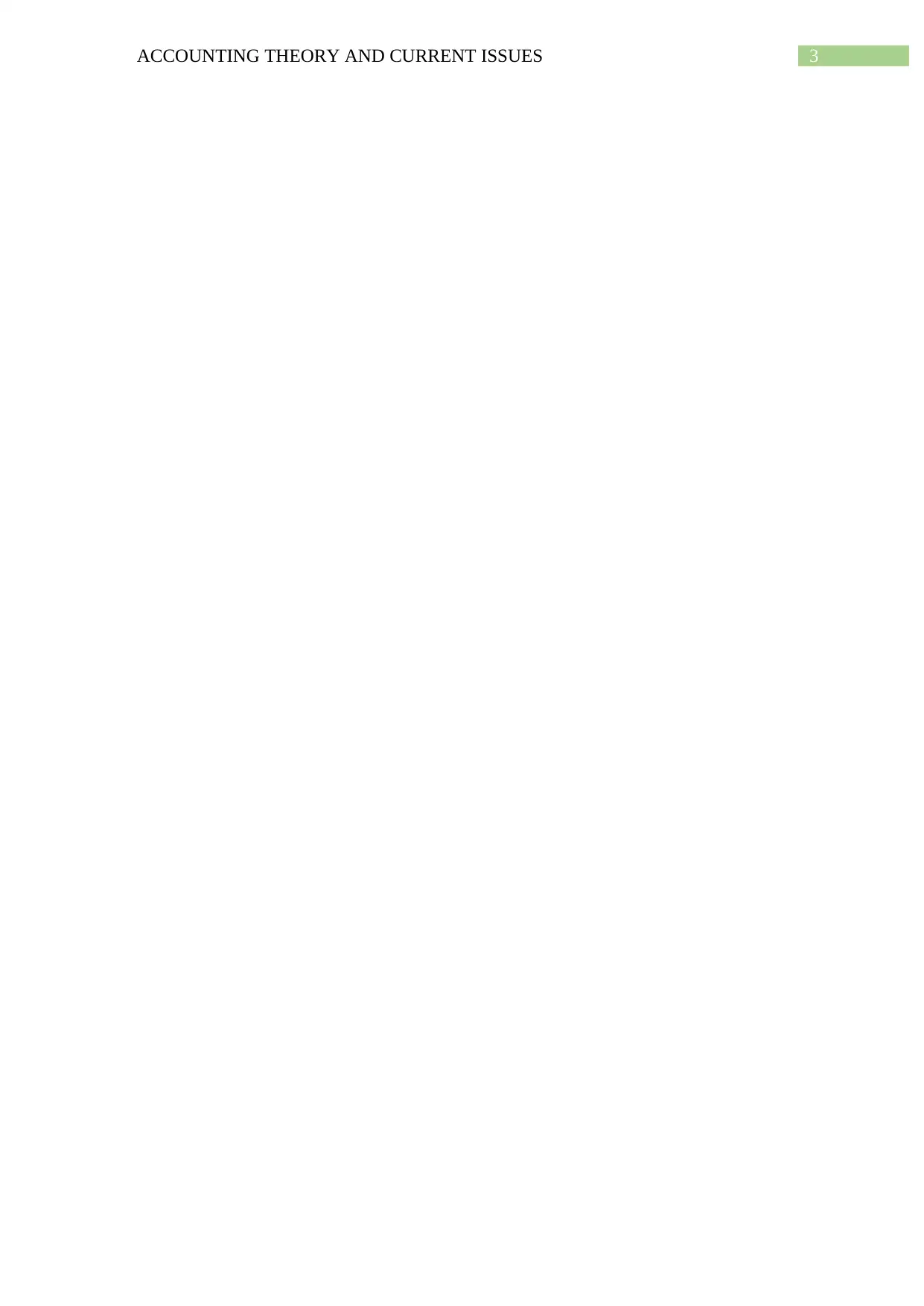
3ACCOUNTING THEORY AND CURRENT ISSUES
Secure Best Marks with AI Grader
Need help grading? Try our AI Grader for instant feedback on your assignments.

4ACCOUNTING THEORY AND CURRENT ISSUES
Introduction
The main aim of this report can be found in the discussion on different accounting
theories along with their application in some of the major accounting issues. The objectives
of the report can be divided into five parts. The aim of the first part of the report is to analysis
and valuation of certain qualitative characteristics of financial reporting that are missing in
the current financial reporting practices of IFRS. The aim of the next part of this report is to
analyse the decision of Australian Government to amend Corporations Act through three
accounting theories; they are public interest theory, capture theory and economic interest
group theory. The objective of the next part of the report is to review the decision of the
firms’ directors not to do the revaluation of the property, plant and equipment (PPE). The
next part of the report considers the analysis of the accounting practice for impairment in an
ASX listed company; and Woolworths Group Limited is considered for this purpose. The last
part of the report analytically reviews the impact of former and new lease standards on
company financial reporting.
Woolworths Group Limited (Woolworths) is one of the leading Australian companies
having operating in the retail industry throughout Australia and New Zealand. It is considered
as the second largest Australian company relating to revenue. Woolworths was established in
the year of 1924 and is headquartered at Bella Vista, New South Wales, Australia
(woolworthsgroup.com.au 2019).
Assessment A
Financial information become beneficial to the users when they have the needed
qualitative financial reporting characteristics. The fundamental qualitative characteristics are
relevance and faithful representation; and the enhancing qualitative characteristics are
comparability, verifiability, understandability and timeliness (iasplus.com 2019). The
Introduction
The main aim of this report can be found in the discussion on different accounting
theories along with their application in some of the major accounting issues. The objectives
of the report can be divided into five parts. The aim of the first part of the report is to analysis
and valuation of certain qualitative characteristics of financial reporting that are missing in
the current financial reporting practices of IFRS. The aim of the next part of this report is to
analyse the decision of Australian Government to amend Corporations Act through three
accounting theories; they are public interest theory, capture theory and economic interest
group theory. The objective of the next part of the report is to review the decision of the
firms’ directors not to do the revaluation of the property, plant and equipment (PPE). The
next part of the report considers the analysis of the accounting practice for impairment in an
ASX listed company; and Woolworths Group Limited is considered for this purpose. The last
part of the report analytically reviews the impact of former and new lease standards on
company financial reporting.
Woolworths Group Limited (Woolworths) is one of the leading Australian companies
having operating in the retail industry throughout Australia and New Zealand. It is considered
as the second largest Australian company relating to revenue. Woolworths was established in
the year of 1924 and is headquartered at Bella Vista, New South Wales, Australia
(woolworthsgroup.com.au 2019).
Assessment A
Financial information become beneficial to the users when they have the needed
qualitative financial reporting characteristics. The fundamental qualitative characteristics are
relevance and faithful representation; and the enhancing qualitative characteristics are
comparability, verifiability, understandability and timeliness (iasplus.com 2019). The
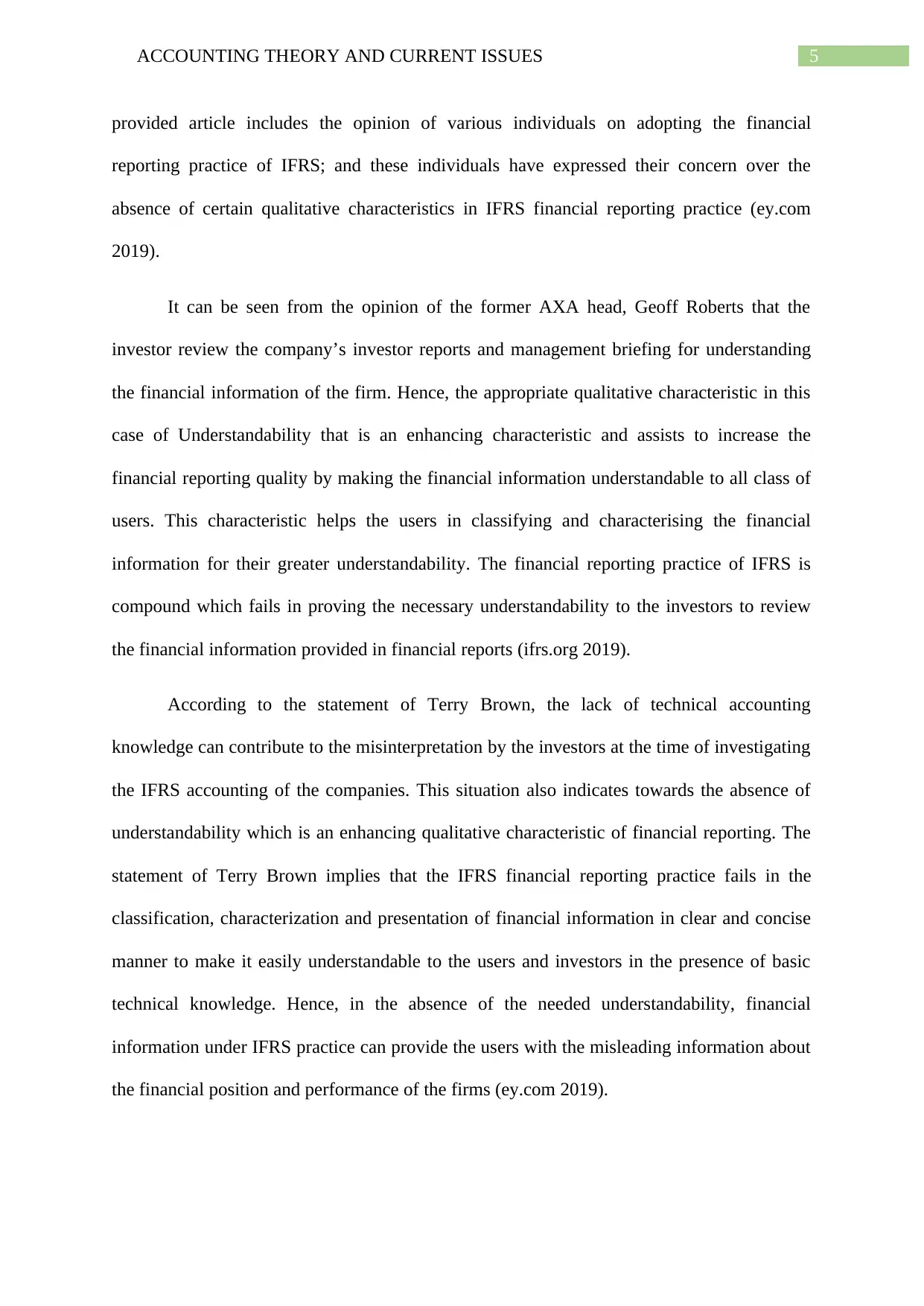
5ACCOUNTING THEORY AND CURRENT ISSUES
provided article includes the opinion of various individuals on adopting the financial
reporting practice of IFRS; and these individuals have expressed their concern over the
absence of certain qualitative characteristics in IFRS financial reporting practice (ey.com
2019).
It can be seen from the opinion of the former AXA head, Geoff Roberts that the
investor review the company’s investor reports and management briefing for understanding
the financial information of the firm. Hence, the appropriate qualitative characteristic in this
case of Understandability that is an enhancing characteristic and assists to increase the
financial reporting quality by making the financial information understandable to all class of
users. This characteristic helps the users in classifying and characterising the financial
information for their greater understandability. The financial reporting practice of IFRS is
compound which fails in proving the necessary understandability to the investors to review
the financial information provided in financial reports (ifrs.org 2019).
According to the statement of Terry Brown, the lack of technical accounting
knowledge can contribute to the misinterpretation by the investors at the time of investigating
the IFRS accounting of the companies. This situation also indicates towards the absence of
understandability which is an enhancing qualitative characteristic of financial reporting. The
statement of Terry Brown implies that the IFRS financial reporting practice fails in the
classification, characterization and presentation of financial information in clear and concise
manner to make it easily understandable to the users and investors in the presence of basic
technical knowledge. Hence, in the absence of the needed understandability, financial
information under IFRS practice can provide the users with the misleading information about
the financial position and performance of the firms (ey.com 2019).
provided article includes the opinion of various individuals on adopting the financial
reporting practice of IFRS; and these individuals have expressed their concern over the
absence of certain qualitative characteristics in IFRS financial reporting practice (ey.com
2019).
It can be seen from the opinion of the former AXA head, Geoff Roberts that the
investor review the company’s investor reports and management briefing for understanding
the financial information of the firm. Hence, the appropriate qualitative characteristic in this
case of Understandability that is an enhancing characteristic and assists to increase the
financial reporting quality by making the financial information understandable to all class of
users. This characteristic helps the users in classifying and characterising the financial
information for their greater understandability. The financial reporting practice of IFRS is
compound which fails in proving the necessary understandability to the investors to review
the financial information provided in financial reports (ifrs.org 2019).
According to the statement of Terry Brown, the lack of technical accounting
knowledge can contribute to the misinterpretation by the investors at the time of investigating
the IFRS accounting of the companies. This situation also indicates towards the absence of
understandability which is an enhancing qualitative characteristic of financial reporting. The
statement of Terry Brown implies that the IFRS financial reporting practice fails in the
classification, characterization and presentation of financial information in clear and concise
manner to make it easily understandable to the users and investors in the presence of basic
technical knowledge. Hence, in the absence of the needed understandability, financial
information under IFRS practice can provide the users with the misleading information about
the financial position and performance of the firms (ey.com 2019).
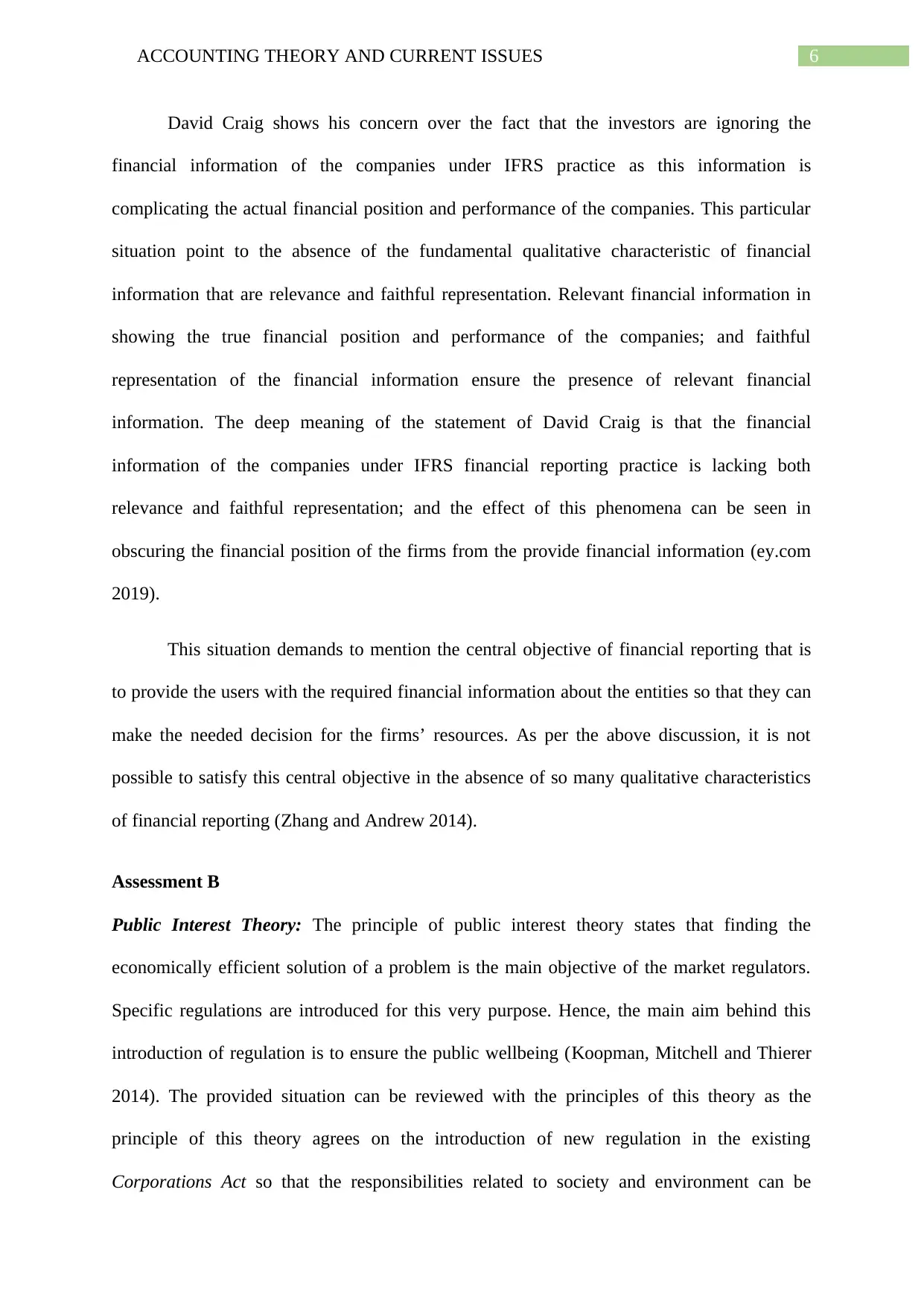
6ACCOUNTING THEORY AND CURRENT ISSUES
David Craig shows his concern over the fact that the investors are ignoring the
financial information of the companies under IFRS practice as this information is
complicating the actual financial position and performance of the companies. This particular
situation point to the absence of the fundamental qualitative characteristic of financial
information that are relevance and faithful representation. Relevant financial information in
showing the true financial position and performance of the companies; and faithful
representation of the financial information ensure the presence of relevant financial
information. The deep meaning of the statement of David Craig is that the financial
information of the companies under IFRS financial reporting practice is lacking both
relevance and faithful representation; and the effect of this phenomena can be seen in
obscuring the financial position of the firms from the provide financial information (ey.com
2019).
This situation demands to mention the central objective of financial reporting that is
to provide the users with the required financial information about the entities so that they can
make the needed decision for the firms’ resources. As per the above discussion, it is not
possible to satisfy this central objective in the absence of so many qualitative characteristics
of financial reporting (Zhang and Andrew 2014).
Assessment B
Public Interest Theory: The principle of public interest theory states that finding the
economically efficient solution of a problem is the main objective of the market regulators.
Specific regulations are introduced for this very purpose. Hence, the main aim behind this
introduction of regulation is to ensure the public wellbeing (Koopman, Mitchell and Thierer
2014). The provided situation can be reviewed with the principles of this theory as the
principle of this theory agrees on the introduction of new regulation in the existing
Corporations Act so that the responsibilities related to society and environment can be
David Craig shows his concern over the fact that the investors are ignoring the
financial information of the companies under IFRS practice as this information is
complicating the actual financial position and performance of the companies. This particular
situation point to the absence of the fundamental qualitative characteristic of financial
information that are relevance and faithful representation. Relevant financial information in
showing the true financial position and performance of the companies; and faithful
representation of the financial information ensure the presence of relevant financial
information. The deep meaning of the statement of David Craig is that the financial
information of the companies under IFRS financial reporting practice is lacking both
relevance and faithful representation; and the effect of this phenomena can be seen in
obscuring the financial position of the firms from the provide financial information (ey.com
2019).
This situation demands to mention the central objective of financial reporting that is
to provide the users with the required financial information about the entities so that they can
make the needed decision for the firms’ resources. As per the above discussion, it is not
possible to satisfy this central objective in the absence of so many qualitative characteristics
of financial reporting (Zhang and Andrew 2014).
Assessment B
Public Interest Theory: The principle of public interest theory states that finding the
economically efficient solution of a problem is the main objective of the market regulators.
Specific regulations are introduced for this very purpose. Hence, the main aim behind this
introduction of regulation is to ensure the public wellbeing (Koopman, Mitchell and Thierer
2014). The provided situation can be reviewed with the principles of this theory as the
principle of this theory agrees on the introduction of new regulation in the existing
Corporations Act so that the responsibilities related to society and environment can be
Paraphrase This Document
Need a fresh take? Get an instant paraphrase of this document with our AI Paraphraser
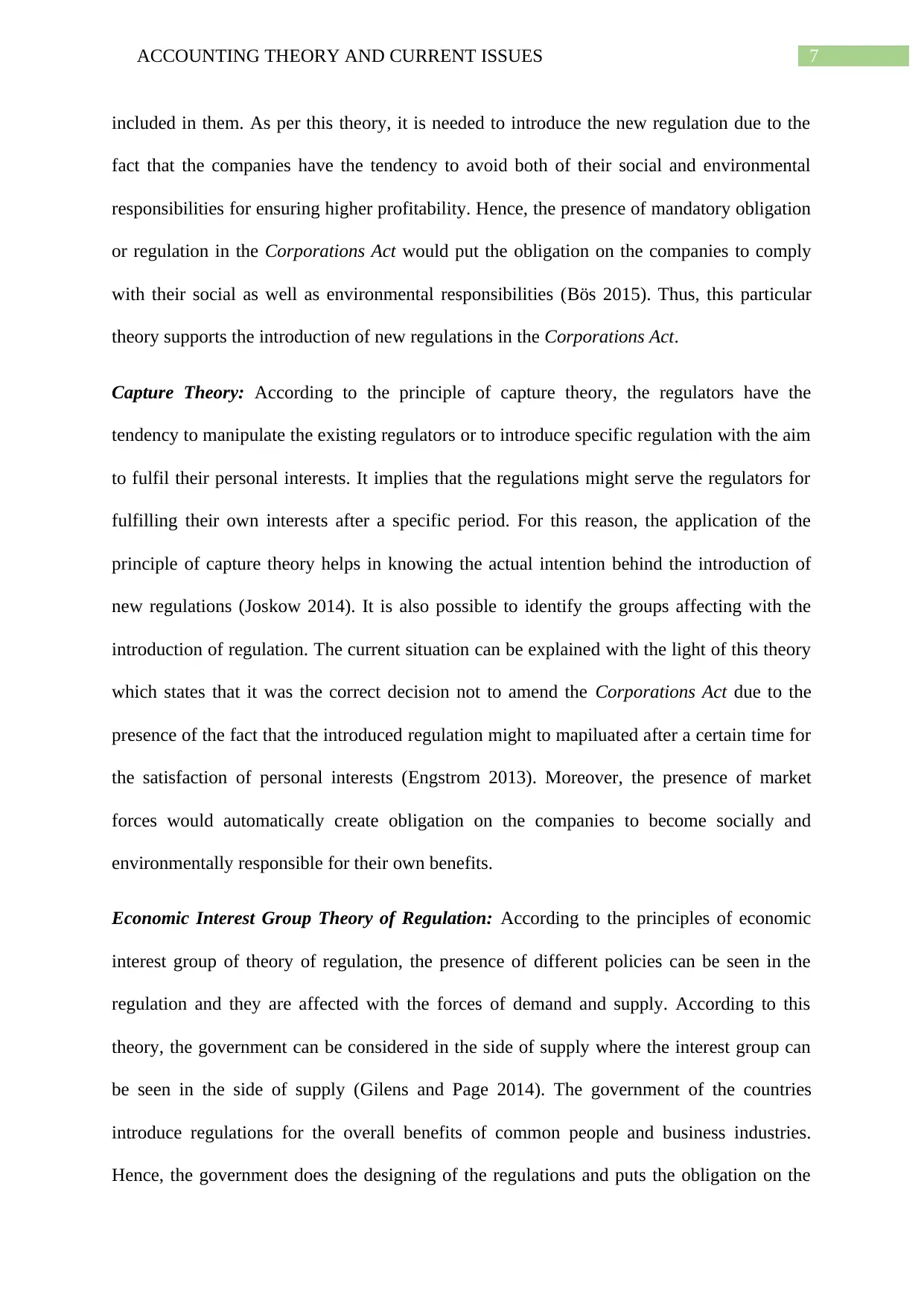
7ACCOUNTING THEORY AND CURRENT ISSUES
included in them. As per this theory, it is needed to introduce the new regulation due to the
fact that the companies have the tendency to avoid both of their social and environmental
responsibilities for ensuring higher profitability. Hence, the presence of mandatory obligation
or regulation in the Corporations Act would put the obligation on the companies to comply
with their social as well as environmental responsibilities (Bös 2015). Thus, this particular
theory supports the introduction of new regulations in the Corporations Act.
Capture Theory: According to the principle of capture theory, the regulators have the
tendency to manipulate the existing regulators or to introduce specific regulation with the aim
to fulfil their personal interests. It implies that the regulations might serve the regulators for
fulfilling their own interests after a specific period. For this reason, the application of the
principle of capture theory helps in knowing the actual intention behind the introduction of
new regulations (Joskow 2014). It is also possible to identify the groups affecting with the
introduction of regulation. The current situation can be explained with the light of this theory
which states that it was the correct decision not to amend the Corporations Act due to the
presence of the fact that the introduced regulation might to mapiluated after a certain time for
the satisfaction of personal interests (Engstrom 2013). Moreover, the presence of market
forces would automatically create obligation on the companies to become socially and
environmentally responsible for their own benefits.
Economic Interest Group Theory of Regulation: According to the principles of economic
interest group of theory of regulation, the presence of different policies can be seen in the
regulation and they are affected with the forces of demand and supply. According to this
theory, the government can be considered in the side of supply where the interest group can
be seen in the side of supply (Gilens and Page 2014). The government of the countries
introduce regulations for the overall benefits of common people and business industries.
Hence, the government does the designing of the regulations and puts the obligation on the
included in them. As per this theory, it is needed to introduce the new regulation due to the
fact that the companies have the tendency to avoid both of their social and environmental
responsibilities for ensuring higher profitability. Hence, the presence of mandatory obligation
or regulation in the Corporations Act would put the obligation on the companies to comply
with their social as well as environmental responsibilities (Bös 2015). Thus, this particular
theory supports the introduction of new regulations in the Corporations Act.
Capture Theory: According to the principle of capture theory, the regulators have the
tendency to manipulate the existing regulators or to introduce specific regulation with the aim
to fulfil their personal interests. It implies that the regulations might serve the regulators for
fulfilling their own interests after a specific period. For this reason, the application of the
principle of capture theory helps in knowing the actual intention behind the introduction of
new regulations (Joskow 2014). It is also possible to identify the groups affecting with the
introduction of regulation. The current situation can be explained with the light of this theory
which states that it was the correct decision not to amend the Corporations Act due to the
presence of the fact that the introduced regulation might to mapiluated after a certain time for
the satisfaction of personal interests (Engstrom 2013). Moreover, the presence of market
forces would automatically create obligation on the companies to become socially and
environmentally responsible for their own benefits.
Economic Interest Group Theory of Regulation: According to the principles of economic
interest group of theory of regulation, the presence of different policies can be seen in the
regulation and they are affected with the forces of demand and supply. According to this
theory, the government can be considered in the side of supply where the interest group can
be seen in the side of supply (Gilens and Page 2014). The government of the countries
introduce regulations for the overall benefits of common people and business industries.
Hence, the government does the designing of the regulations and puts the obligation on the
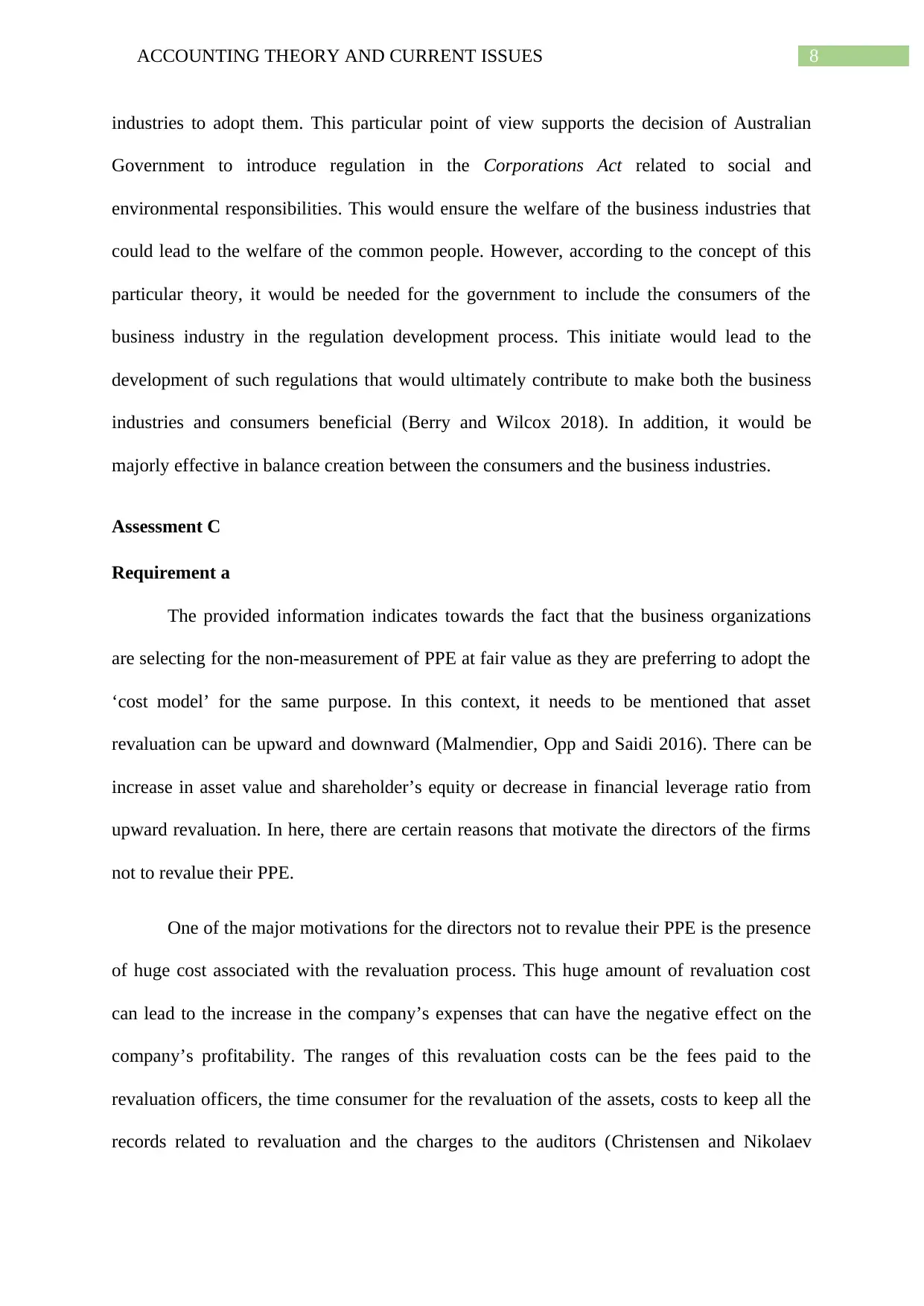
8ACCOUNTING THEORY AND CURRENT ISSUES
industries to adopt them. This particular point of view supports the decision of Australian
Government to introduce regulation in the Corporations Act related to social and
environmental responsibilities. This would ensure the welfare of the business industries that
could lead to the welfare of the common people. However, according to the concept of this
particular theory, it would be needed for the government to include the consumers of the
business industry in the regulation development process. This initiate would lead to the
development of such regulations that would ultimately contribute to make both the business
industries and consumers beneficial (Berry and Wilcox 2018). In addition, it would be
majorly effective in balance creation between the consumers and the business industries.
Assessment C
Requirement a
The provided information indicates towards the fact that the business organizations
are selecting for the non-measurement of PPE at fair value as they are preferring to adopt the
‘cost model’ for the same purpose. In this context, it needs to be mentioned that asset
revaluation can be upward and downward (Malmendier, Opp and Saidi 2016). There can be
increase in asset value and shareholder’s equity or decrease in financial leverage ratio from
upward revaluation. In here, there are certain reasons that motivate the directors of the firms
not to revalue their PPE.
One of the major motivations for the directors not to revalue their PPE is the presence
of huge cost associated with the revaluation process. This huge amount of revaluation cost
can lead to the increase in the company’s expenses that can have the negative effect on the
company’s profitability. The ranges of this revaluation costs can be the fees paid to the
revaluation officers, the time consumer for the revaluation of the assets, costs to keep all the
records related to revaluation and the charges to the auditors (Christensen and Nikolaev
industries to adopt them. This particular point of view supports the decision of Australian
Government to introduce regulation in the Corporations Act related to social and
environmental responsibilities. This would ensure the welfare of the business industries that
could lead to the welfare of the common people. However, according to the concept of this
particular theory, it would be needed for the government to include the consumers of the
business industry in the regulation development process. This initiate would lead to the
development of such regulations that would ultimately contribute to make both the business
industries and consumers beneficial (Berry and Wilcox 2018). In addition, it would be
majorly effective in balance creation between the consumers and the business industries.
Assessment C
Requirement a
The provided information indicates towards the fact that the business organizations
are selecting for the non-measurement of PPE at fair value as they are preferring to adopt the
‘cost model’ for the same purpose. In this context, it needs to be mentioned that asset
revaluation can be upward and downward (Malmendier, Opp and Saidi 2016). There can be
increase in asset value and shareholder’s equity or decrease in financial leverage ratio from
upward revaluation. In here, there are certain reasons that motivate the directors of the firms
not to revalue their PPE.
One of the major motivations for the directors not to revalue their PPE is the presence
of huge cost associated with the revaluation process. This huge amount of revaluation cost
can lead to the increase in the company’s expenses that can have the negative effect on the
company’s profitability. The ranges of this revaluation costs can be the fees paid to the
revaluation officers, the time consumer for the revaluation of the assets, costs to keep all the
records related to revaluation and the charges to the auditors (Christensen and Nikolaev
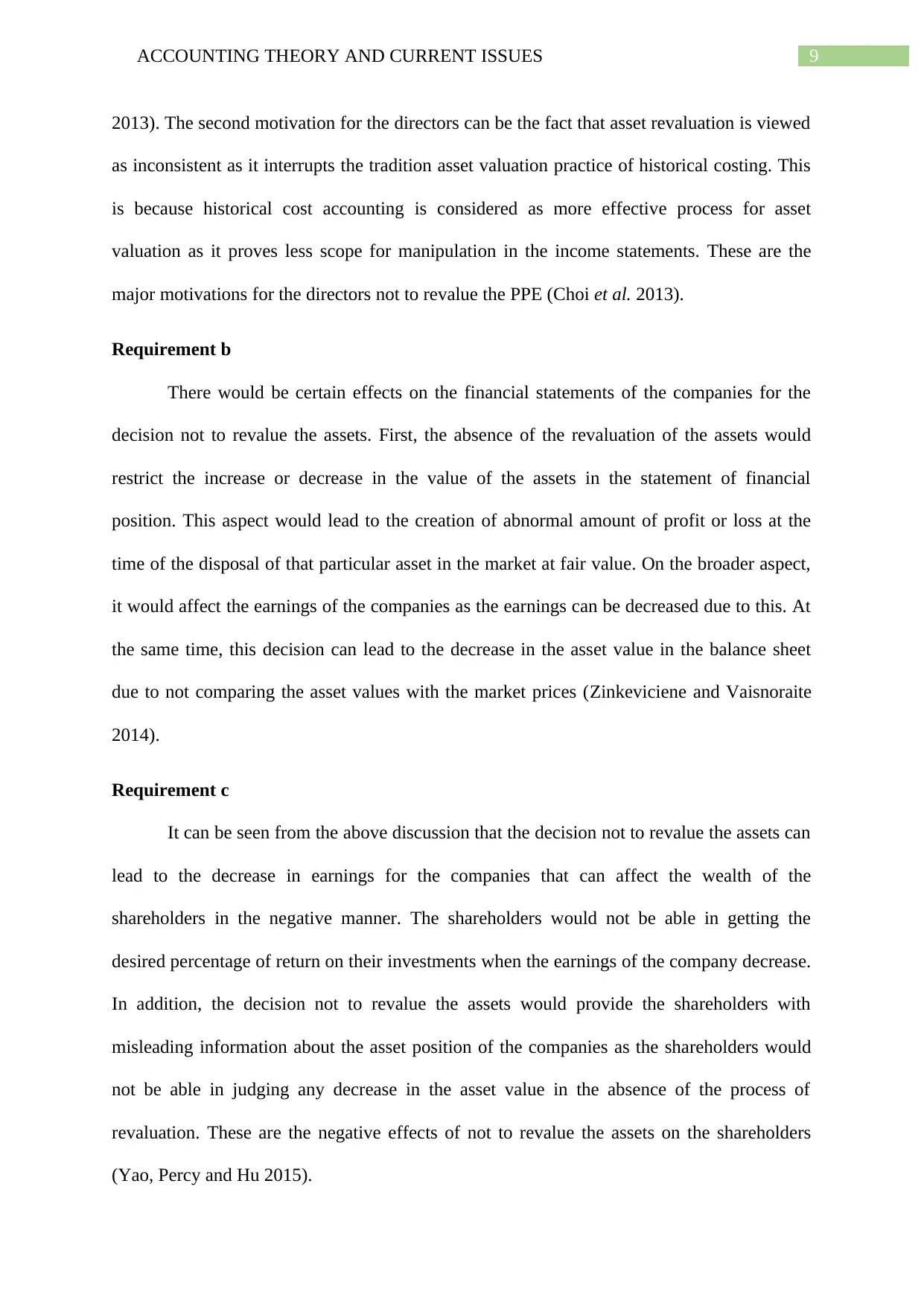
9ACCOUNTING THEORY AND CURRENT ISSUES
2013). The second motivation for the directors can be the fact that asset revaluation is viewed
as inconsistent as it interrupts the tradition asset valuation practice of historical costing. This
is because historical cost accounting is considered as more effective process for asset
valuation as it proves less scope for manipulation in the income statements. These are the
major motivations for the directors not to revalue the PPE (Choi et al. 2013).
Requirement b
There would be certain effects on the financial statements of the companies for the
decision not to revalue the assets. First, the absence of the revaluation of the assets would
restrict the increase or decrease in the value of the assets in the statement of financial
position. This aspect would lead to the creation of abnormal amount of profit or loss at the
time of the disposal of that particular asset in the market at fair value. On the broader aspect,
it would affect the earnings of the companies as the earnings can be decreased due to this. At
the same time, this decision can lead to the decrease in the asset value in the balance sheet
due to not comparing the asset values with the market prices (Zinkeviciene and Vaisnoraite
2014).
Requirement c
It can be seen from the above discussion that the decision not to revalue the assets can
lead to the decrease in earnings for the companies that can affect the wealth of the
shareholders in the negative manner. The shareholders would not be able in getting the
desired percentage of return on their investments when the earnings of the company decrease.
In addition, the decision not to revalue the assets would provide the shareholders with
misleading information about the asset position of the companies as the shareholders would
not be able in judging any decrease in the asset value in the absence of the process of
revaluation. These are the negative effects of not to revalue the assets on the shareholders
(Yao, Percy and Hu 2015).
2013). The second motivation for the directors can be the fact that asset revaluation is viewed
as inconsistent as it interrupts the tradition asset valuation practice of historical costing. This
is because historical cost accounting is considered as more effective process for asset
valuation as it proves less scope for manipulation in the income statements. These are the
major motivations for the directors not to revalue the PPE (Choi et al. 2013).
Requirement b
There would be certain effects on the financial statements of the companies for the
decision not to revalue the assets. First, the absence of the revaluation of the assets would
restrict the increase or decrease in the value of the assets in the statement of financial
position. This aspect would lead to the creation of abnormal amount of profit or loss at the
time of the disposal of that particular asset in the market at fair value. On the broader aspect,
it would affect the earnings of the companies as the earnings can be decreased due to this. At
the same time, this decision can lead to the decrease in the asset value in the balance sheet
due to not comparing the asset values with the market prices (Zinkeviciene and Vaisnoraite
2014).
Requirement c
It can be seen from the above discussion that the decision not to revalue the assets can
lead to the decrease in earnings for the companies that can affect the wealth of the
shareholders in the negative manner. The shareholders would not be able in getting the
desired percentage of return on their investments when the earnings of the company decrease.
In addition, the decision not to revalue the assets would provide the shareholders with
misleading information about the asset position of the companies as the shareholders would
not be able in judging any decrease in the asset value in the absence of the process of
revaluation. These are the negative effects of not to revalue the assets on the shareholders
(Yao, Percy and Hu 2015).
Secure Best Marks with AI Grader
Need help grading? Try our AI Grader for instant feedback on your assignments.
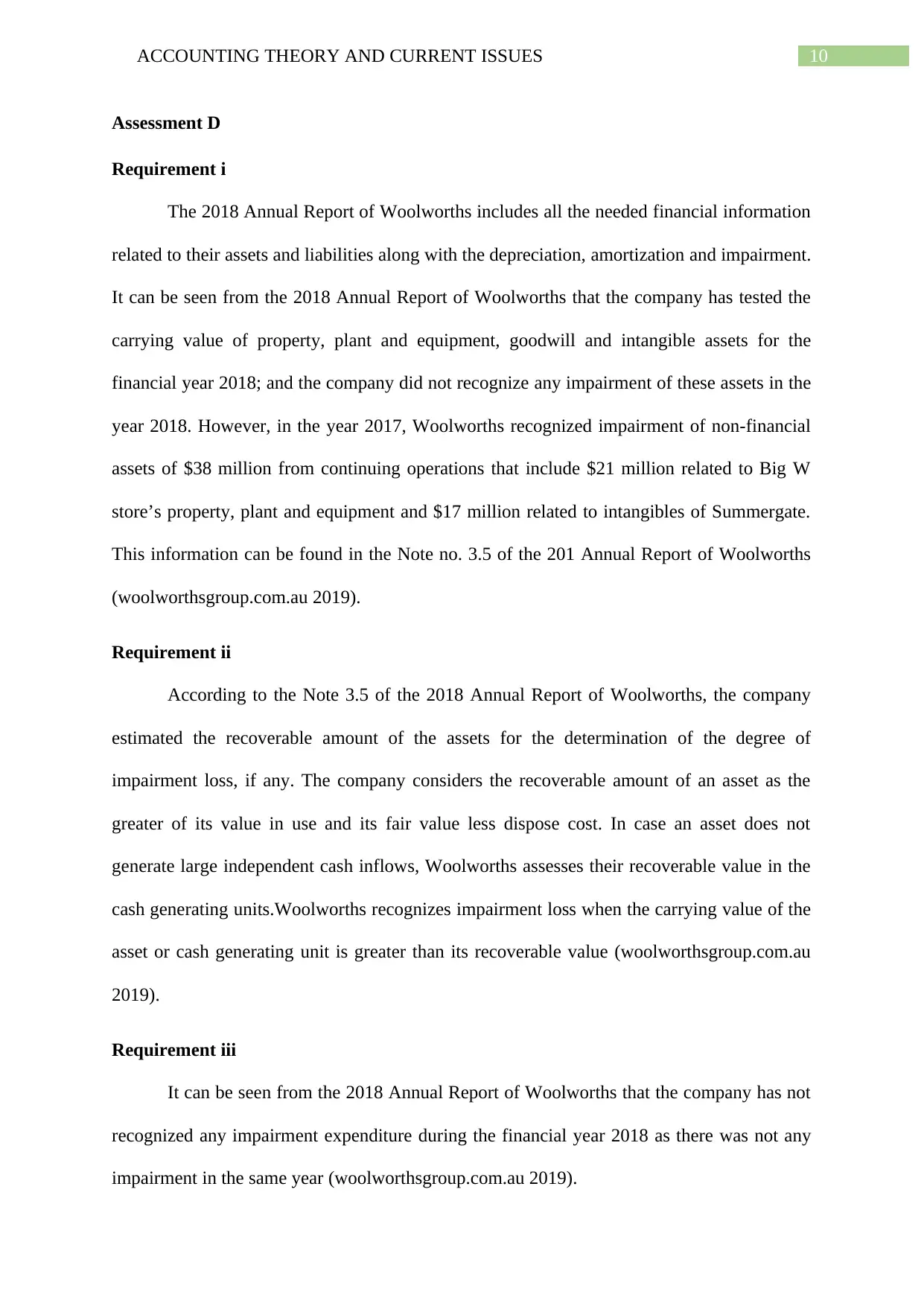
10ACCOUNTING THEORY AND CURRENT ISSUES
Assessment D
Requirement i
The 2018 Annual Report of Woolworths includes all the needed financial information
related to their assets and liabilities along with the depreciation, amortization and impairment.
It can be seen from the 2018 Annual Report of Woolworths that the company has tested the
carrying value of property, plant and equipment, goodwill and intangible assets for the
financial year 2018; and the company did not recognize any impairment of these assets in the
year 2018. However, in the year 2017, Woolworths recognized impairment of non-financial
assets of $38 million from continuing operations that include $21 million related to Big W
store’s property, plant and equipment and $17 million related to intangibles of Summergate.
This information can be found in the Note no. 3.5 of the 201 Annual Report of Woolworths
(woolworthsgroup.com.au 2019).
Requirement ii
According to the Note 3.5 of the 2018 Annual Report of Woolworths, the company
estimated the recoverable amount of the assets for the determination of the degree of
impairment loss, if any. The company considers the recoverable amount of an asset as the
greater of its value in use and its fair value less dispose cost. In case an asset does not
generate large independent cash inflows, Woolworths assesses their recoverable value in the
cash generating units.Woolworths recognizes impairment loss when the carrying value of the
asset or cash generating unit is greater than its recoverable value (woolworthsgroup.com.au
2019).
Requirement iii
It can be seen from the 2018 Annual Report of Woolworths that the company has not
recognized any impairment expenditure during the financial year 2018 as there was not any
impairment in the same year (woolworthsgroup.com.au 2019).
Assessment D
Requirement i
The 2018 Annual Report of Woolworths includes all the needed financial information
related to their assets and liabilities along with the depreciation, amortization and impairment.
It can be seen from the 2018 Annual Report of Woolworths that the company has tested the
carrying value of property, plant and equipment, goodwill and intangible assets for the
financial year 2018; and the company did not recognize any impairment of these assets in the
year 2018. However, in the year 2017, Woolworths recognized impairment of non-financial
assets of $38 million from continuing operations that include $21 million related to Big W
store’s property, plant and equipment and $17 million related to intangibles of Summergate.
This information can be found in the Note no. 3.5 of the 201 Annual Report of Woolworths
(woolworthsgroup.com.au 2019).
Requirement ii
According to the Note 3.5 of the 2018 Annual Report of Woolworths, the company
estimated the recoverable amount of the assets for the determination of the degree of
impairment loss, if any. The company considers the recoverable amount of an asset as the
greater of its value in use and its fair value less dispose cost. In case an asset does not
generate large independent cash inflows, Woolworths assesses their recoverable value in the
cash generating units.Woolworths recognizes impairment loss when the carrying value of the
asset or cash generating unit is greater than its recoverable value (woolworthsgroup.com.au
2019).
Requirement iii
It can be seen from the 2018 Annual Report of Woolworths that the company has not
recognized any impairment expenditure during the financial year 2018 as there was not any
impairment in the same year (woolworthsgroup.com.au 2019).
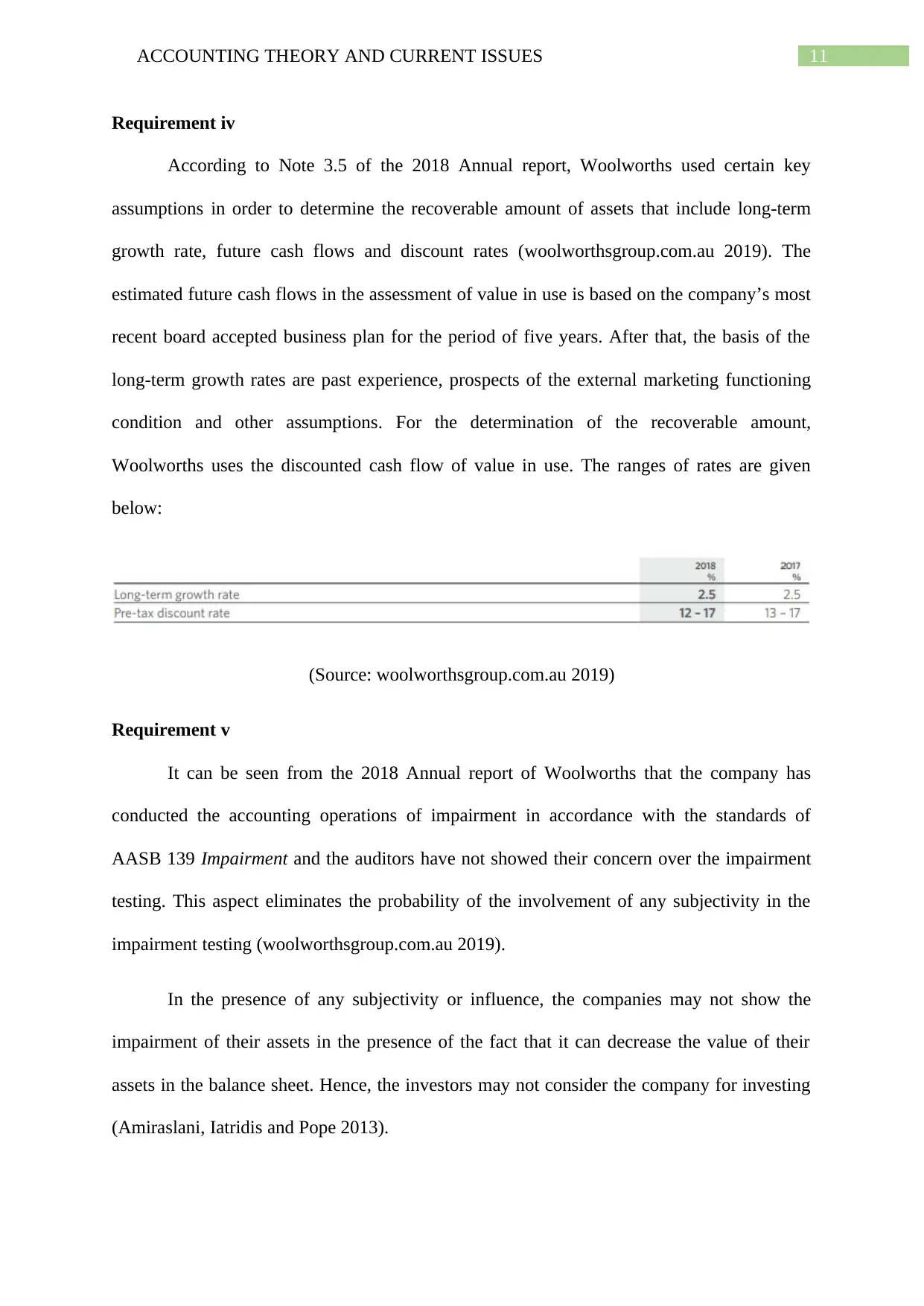
11ACCOUNTING THEORY AND CURRENT ISSUES
Requirement iv
According to Note 3.5 of the 2018 Annual report, Woolworths used certain key
assumptions in order to determine the recoverable amount of assets that include long-term
growth rate, future cash flows and discount rates (woolworthsgroup.com.au 2019). The
estimated future cash flows in the assessment of value in use is based on the company’s most
recent board accepted business plan for the period of five years. After that, the basis of the
long-term growth rates are past experience, prospects of the external marketing functioning
condition and other assumptions. For the determination of the recoverable amount,
Woolworths uses the discounted cash flow of value in use. The ranges of rates are given
below:
(Source: woolworthsgroup.com.au 2019)
Requirement v
It can be seen from the 2018 Annual report of Woolworths that the company has
conducted the accounting operations of impairment in accordance with the standards of
AASB 139 Impairment and the auditors have not showed their concern over the impairment
testing. This aspect eliminates the probability of the involvement of any subjectivity in the
impairment testing (woolworthsgroup.com.au 2019).
In the presence of any subjectivity or influence, the companies may not show the
impairment of their assets in the presence of the fact that it can decrease the value of their
assets in the balance sheet. Hence, the investors may not consider the company for investing
(Amiraslani, Iatridis and Pope 2013).
Requirement iv
According to Note 3.5 of the 2018 Annual report, Woolworths used certain key
assumptions in order to determine the recoverable amount of assets that include long-term
growth rate, future cash flows and discount rates (woolworthsgroup.com.au 2019). The
estimated future cash flows in the assessment of value in use is based on the company’s most
recent board accepted business plan for the period of five years. After that, the basis of the
long-term growth rates are past experience, prospects of the external marketing functioning
condition and other assumptions. For the determination of the recoverable amount,
Woolworths uses the discounted cash flow of value in use. The ranges of rates are given
below:
(Source: woolworthsgroup.com.au 2019)
Requirement v
It can be seen from the 2018 Annual report of Woolworths that the company has
conducted the accounting operations of impairment in accordance with the standards of
AASB 139 Impairment and the auditors have not showed their concern over the impairment
testing. This aspect eliminates the probability of the involvement of any subjectivity in the
impairment testing (woolworthsgroup.com.au 2019).
In the presence of any subjectivity or influence, the companies may not show the
impairment of their assets in the presence of the fact that it can decrease the value of their
assets in the balance sheet. Hence, the investors may not consider the company for investing
(Amiraslani, Iatridis and Pope 2013).

12ACCOUNTING THEORY AND CURRENT ISSUES
Requirement vi
The most interesting aspect in the impairment accounting of Woolworths is the
segregation of all the information related to impairment in the notes to the financial
statements such as method used in impairment, key judgments used and others. However, the
confusing aspect is that Woolworths has provided this information in haphazardly that can
create difficulty for the users to find the required information. It would be better in case all
the lease related information can be obtained from a single section in the annual report.
Requirement vii
One can gain the insight from analysing the impairment testing of Woolworths that
the testing of impairment largely depends on the correct use of assumptions and key
judgments; like discount rate, determination of cash flow and others. This aspect creates the
scope of subjectivity in the impairment testing process.
Requirement viii
Fair value measurement plays a crucial role in the process of impairment testing as
impairment loss is recognized when the carrying value of an asset is lower than its fair value.
Hence, fair value is the current market price of an asset that a company is subject to get at the
time of its selling. In impairment, the recoverable value of an asset is greater than its fair
value (Palea and Maino 2013).
Assessment E
Requirement i
Under the former lease standard, it is the obligation on the companies to classify their
leases as operating and finance lease; and they are not needed to report their leases in balance
sheet. This aspect provides the companies with the opportunity not to report their large
amount of lease liabilities in the balance sheet when the liabilities are actual and have
Requirement vi
The most interesting aspect in the impairment accounting of Woolworths is the
segregation of all the information related to impairment in the notes to the financial
statements such as method used in impairment, key judgments used and others. However, the
confusing aspect is that Woolworths has provided this information in haphazardly that can
create difficulty for the users to find the required information. It would be better in case all
the lease related information can be obtained from a single section in the annual report.
Requirement vii
One can gain the insight from analysing the impairment testing of Woolworths that
the testing of impairment largely depends on the correct use of assumptions and key
judgments; like discount rate, determination of cash flow and others. This aspect creates the
scope of subjectivity in the impairment testing process.
Requirement viii
Fair value measurement plays a crucial role in the process of impairment testing as
impairment loss is recognized when the carrying value of an asset is lower than its fair value.
Hence, fair value is the current market price of an asset that a company is subject to get at the
time of its selling. In impairment, the recoverable value of an asset is greater than its fair
value (Palea and Maino 2013).
Assessment E
Requirement i
Under the former lease standard, it is the obligation on the companies to classify their
leases as operating and finance lease; and they are not needed to report their leases in balance
sheet. This aspect provides the companies with the opportunity not to report their large
amount of lease liabilities in the balance sheet when the liabilities are actual and have
Paraphrase This Document
Need a fresh take? Get an instant paraphrase of this document with our AI Paraphraser
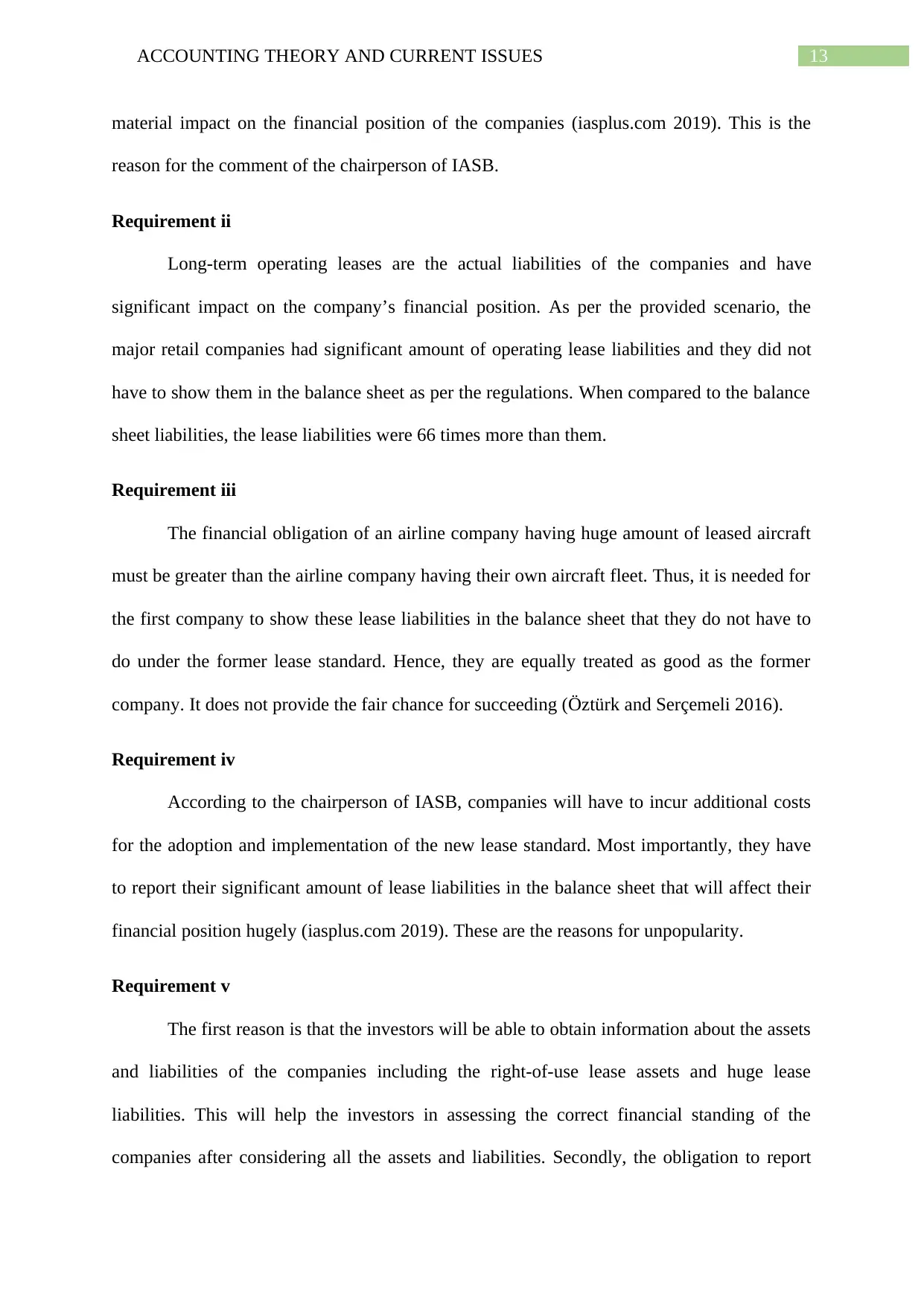
13ACCOUNTING THEORY AND CURRENT ISSUES
material impact on the financial position of the companies (iasplus.com 2019). This is the
reason for the comment of the chairperson of IASB.
Requirement ii
Long-term operating leases are the actual liabilities of the companies and have
significant impact on the company’s financial position. As per the provided scenario, the
major retail companies had significant amount of operating lease liabilities and they did not
have to show them in the balance sheet as per the regulations. When compared to the balance
sheet liabilities, the lease liabilities were 66 times more than them.
Requirement iii
The financial obligation of an airline company having huge amount of leased aircraft
must be greater than the airline company having their own aircraft fleet. Thus, it is needed for
the first company to show these lease liabilities in the balance sheet that they do not have to
do under the former lease standard. Hence, they are equally treated as good as the former
company. It does not provide the fair chance for succeeding (Öztürk and Serçemeli 2016).
Requirement iv
According to the chairperson of IASB, companies will have to incur additional costs
for the adoption and implementation of the new lease standard. Most importantly, they have
to report their significant amount of lease liabilities in the balance sheet that will affect their
financial position hugely (iasplus.com 2019). These are the reasons for unpopularity.
Requirement v
The first reason is that the investors will be able to obtain information about the assets
and liabilities of the companies including the right-of-use lease assets and huge lease
liabilities. This will help the investors in assessing the correct financial standing of the
companies after considering all the assets and liabilities. Secondly, the obligation to report
material impact on the financial position of the companies (iasplus.com 2019). This is the
reason for the comment of the chairperson of IASB.
Requirement ii
Long-term operating leases are the actual liabilities of the companies and have
significant impact on the company’s financial position. As per the provided scenario, the
major retail companies had significant amount of operating lease liabilities and they did not
have to show them in the balance sheet as per the regulations. When compared to the balance
sheet liabilities, the lease liabilities were 66 times more than them.
Requirement iii
The financial obligation of an airline company having huge amount of leased aircraft
must be greater than the airline company having their own aircraft fleet. Thus, it is needed for
the first company to show these lease liabilities in the balance sheet that they do not have to
do under the former lease standard. Hence, they are equally treated as good as the former
company. It does not provide the fair chance for succeeding (Öztürk and Serçemeli 2016).
Requirement iv
According to the chairperson of IASB, companies will have to incur additional costs
for the adoption and implementation of the new lease standard. Most importantly, they have
to report their significant amount of lease liabilities in the balance sheet that will affect their
financial position hugely (iasplus.com 2019). These are the reasons for unpopularity.
Requirement v
The first reason is that the investors will be able to obtain information about the assets
and liabilities of the companies including the right-of-use lease assets and huge lease
liabilities. This will help the investors in assessing the correct financial standing of the
companies after considering all the assets and liabilities. Secondly, the obligation to report
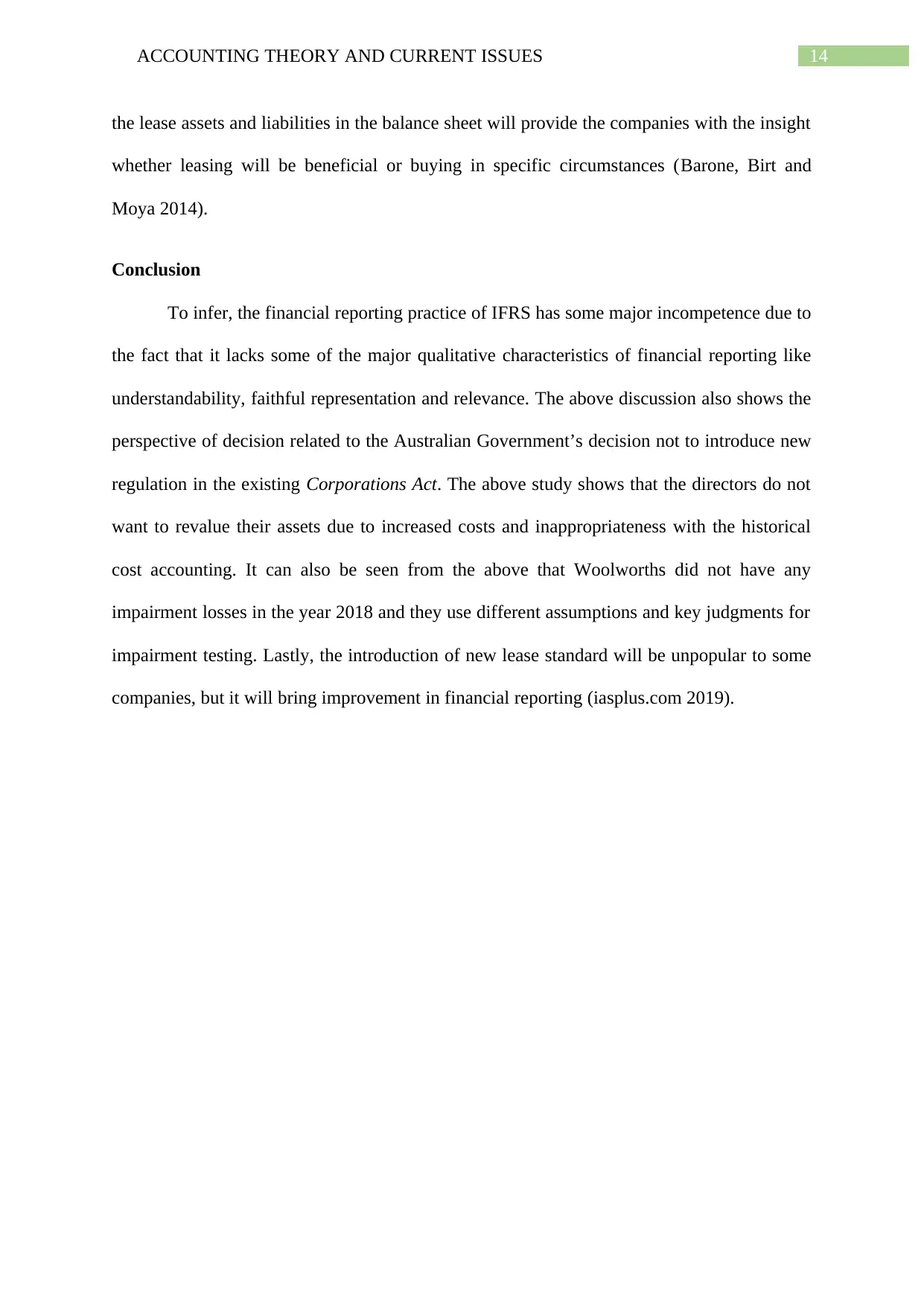
14ACCOUNTING THEORY AND CURRENT ISSUES
the lease assets and liabilities in the balance sheet will provide the companies with the insight
whether leasing will be beneficial or buying in specific circumstances (Barone, Birt and
Moya 2014).
Conclusion
To infer, the financial reporting practice of IFRS has some major incompetence due to
the fact that it lacks some of the major qualitative characteristics of financial reporting like
understandability, faithful representation and relevance. The above discussion also shows the
perspective of decision related to the Australian Government’s decision not to introduce new
regulation in the existing Corporations Act. The above study shows that the directors do not
want to revalue their assets due to increased costs and inappropriateness with the historical
cost accounting. It can also be seen from the above that Woolworths did not have any
impairment losses in the year 2018 and they use different assumptions and key judgments for
impairment testing. Lastly, the introduction of new lease standard will be unpopular to some
companies, but it will bring improvement in financial reporting (iasplus.com 2019).
the lease assets and liabilities in the balance sheet will provide the companies with the insight
whether leasing will be beneficial or buying in specific circumstances (Barone, Birt and
Moya 2014).
Conclusion
To infer, the financial reporting practice of IFRS has some major incompetence due to
the fact that it lacks some of the major qualitative characteristics of financial reporting like
understandability, faithful representation and relevance. The above discussion also shows the
perspective of decision related to the Australian Government’s decision not to introduce new
regulation in the existing Corporations Act. The above study shows that the directors do not
want to revalue their assets due to increased costs and inappropriateness with the historical
cost accounting. It can also be seen from the above that Woolworths did not have any
impairment losses in the year 2018 and they use different assumptions and key judgments for
impairment testing. Lastly, the introduction of new lease standard will be unpopular to some
companies, but it will bring improvement in financial reporting (iasplus.com 2019).
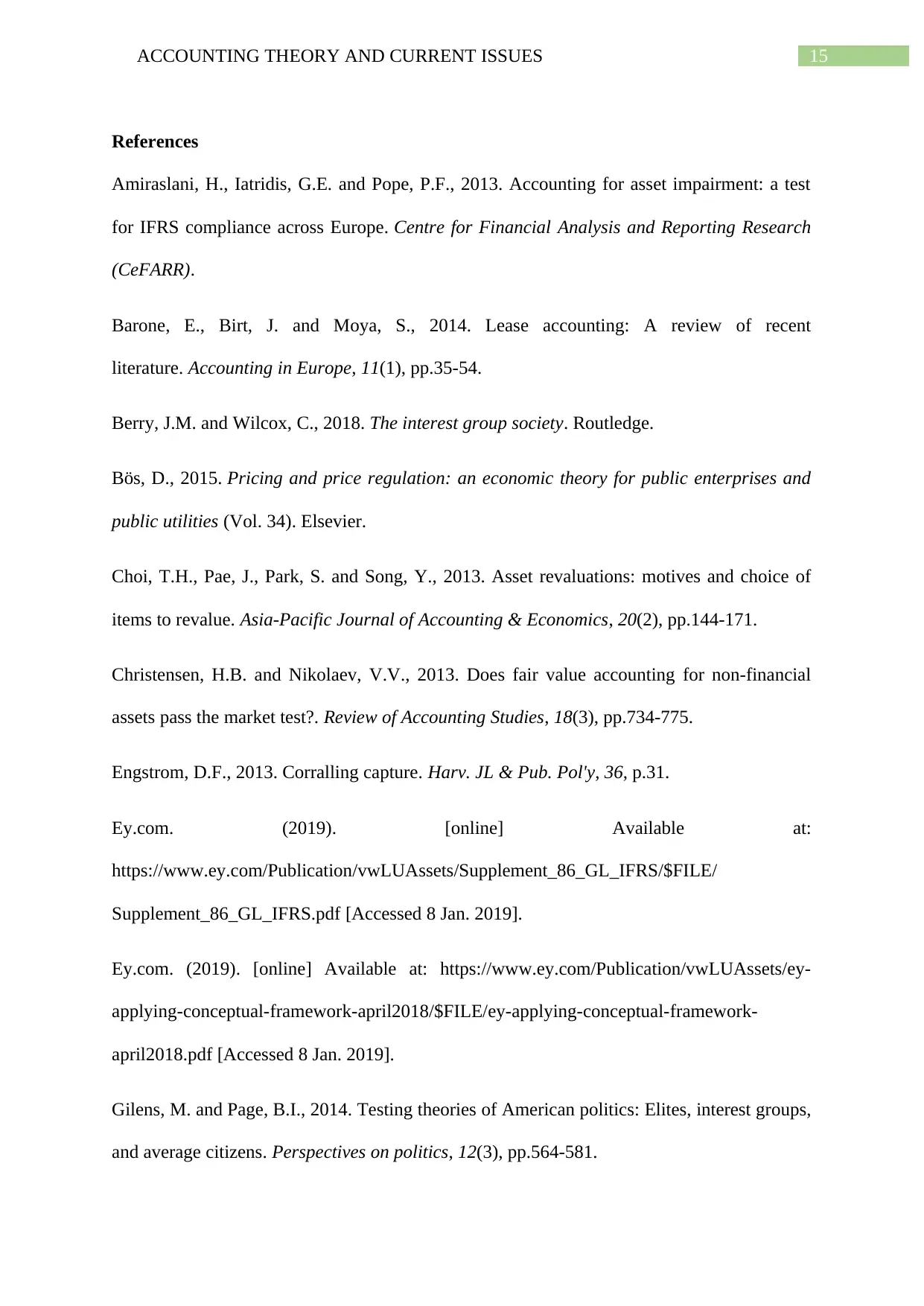
15ACCOUNTING THEORY AND CURRENT ISSUES
References
Amiraslani, H., Iatridis, G.E. and Pope, P.F., 2013. Accounting for asset impairment: a test
for IFRS compliance across Europe. Centre for Financial Analysis and Reporting Research
(CeFARR).
Barone, E., Birt, J. and Moya, S., 2014. Lease accounting: A review of recent
literature. Accounting in Europe, 11(1), pp.35-54.
Berry, J.M. and Wilcox, C., 2018. The interest group society. Routledge.
Bös, D., 2015. Pricing and price regulation: an economic theory for public enterprises and
public utilities (Vol. 34). Elsevier.
Choi, T.H., Pae, J., Park, S. and Song, Y., 2013. Asset revaluations: motives and choice of
items to revalue. Asia-Pacific Journal of Accounting & Economics, 20(2), pp.144-171.
Christensen, H.B. and Nikolaev, V.V., 2013. Does fair value accounting for non-financial
assets pass the market test?. Review of Accounting Studies, 18(3), pp.734-775.
Engstrom, D.F., 2013. Corralling capture. Harv. JL & Pub. Pol'y, 36, p.31.
Ey.com. (2019). [online] Available at:
https://www.ey.com/Publication/vwLUAssets/Supplement_86_GL_IFRS/$FILE/
Supplement_86_GL_IFRS.pdf [Accessed 8 Jan. 2019].
Ey.com. (2019). [online] Available at: https://www.ey.com/Publication/vwLUAssets/ey-
applying-conceptual-framework-april2018/$FILE/ey-applying-conceptual-framework-
april2018.pdf [Accessed 8 Jan. 2019].
Gilens, M. and Page, B.I., 2014. Testing theories of American politics: Elites, interest groups,
and average citizens. Perspectives on politics, 12(3), pp.564-581.
References
Amiraslani, H., Iatridis, G.E. and Pope, P.F., 2013. Accounting for asset impairment: a test
for IFRS compliance across Europe. Centre for Financial Analysis and Reporting Research
(CeFARR).
Barone, E., Birt, J. and Moya, S., 2014. Lease accounting: A review of recent
literature. Accounting in Europe, 11(1), pp.35-54.
Berry, J.M. and Wilcox, C., 2018. The interest group society. Routledge.
Bös, D., 2015. Pricing and price regulation: an economic theory for public enterprises and
public utilities (Vol. 34). Elsevier.
Choi, T.H., Pae, J., Park, S. and Song, Y., 2013. Asset revaluations: motives and choice of
items to revalue. Asia-Pacific Journal of Accounting & Economics, 20(2), pp.144-171.
Christensen, H.B. and Nikolaev, V.V., 2013. Does fair value accounting for non-financial
assets pass the market test?. Review of Accounting Studies, 18(3), pp.734-775.
Engstrom, D.F., 2013. Corralling capture. Harv. JL & Pub. Pol'y, 36, p.31.
Ey.com. (2019). [online] Available at:
https://www.ey.com/Publication/vwLUAssets/Supplement_86_GL_IFRS/$FILE/
Supplement_86_GL_IFRS.pdf [Accessed 8 Jan. 2019].
Ey.com. (2019). [online] Available at: https://www.ey.com/Publication/vwLUAssets/ey-
applying-conceptual-framework-april2018/$FILE/ey-applying-conceptual-framework-
april2018.pdf [Accessed 8 Jan. 2019].
Gilens, M. and Page, B.I., 2014. Testing theories of American politics: Elites, interest groups,
and average citizens. Perspectives on politics, 12(3), pp.564-581.
Secure Best Marks with AI Grader
Need help grading? Try our AI Grader for instant feedback on your assignments.
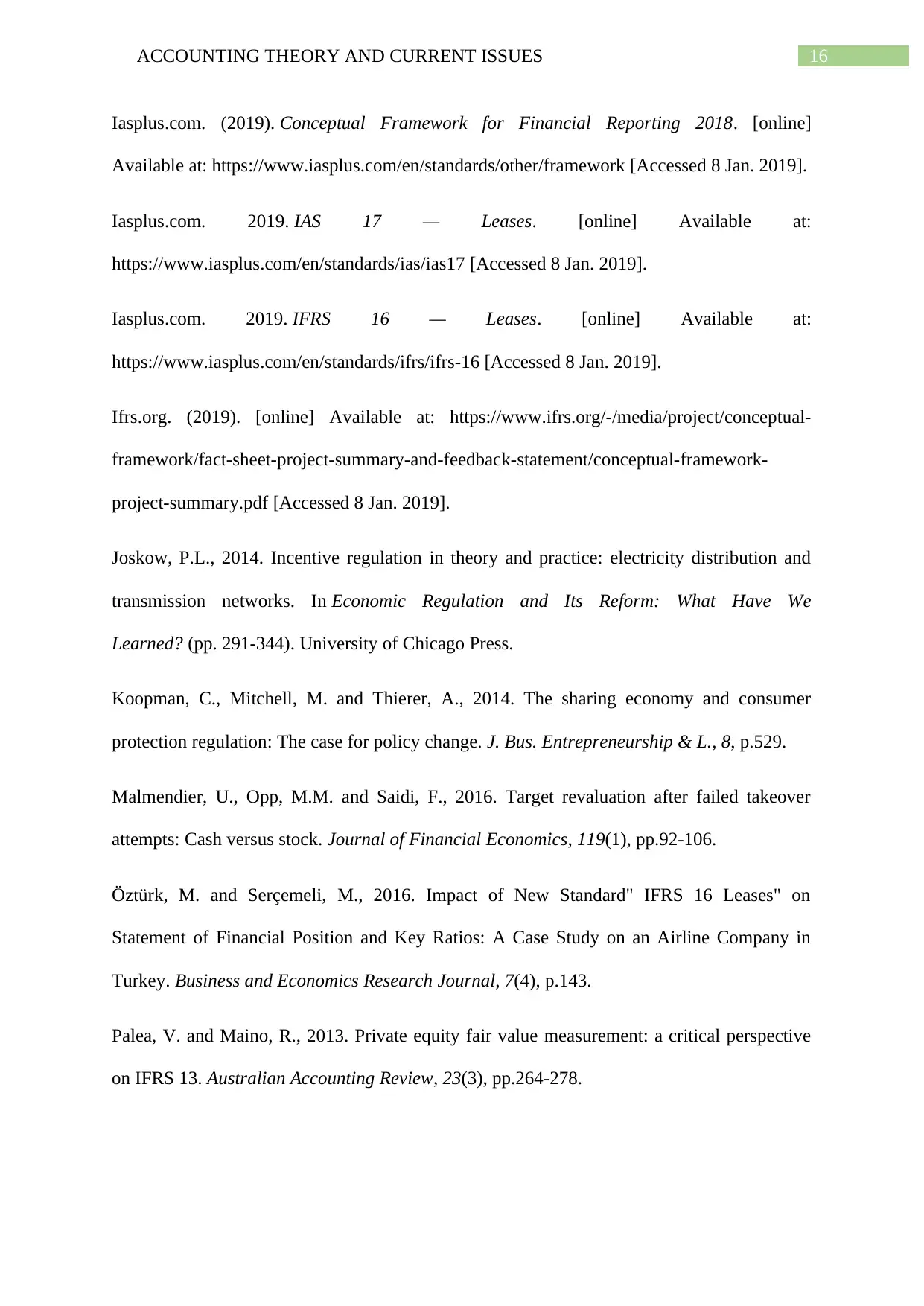
16ACCOUNTING THEORY AND CURRENT ISSUES
Iasplus.com. (2019). Conceptual Framework for Financial Reporting 2018. [online]
Available at: https://www.iasplus.com/en/standards/other/framework [Accessed 8 Jan. 2019].
Iasplus.com. 2019. IAS 17 — Leases. [online] Available at:
https://www.iasplus.com/en/standards/ias/ias17 [Accessed 8 Jan. 2019].
Iasplus.com. 2019. IFRS 16 — Leases. [online] Available at:
https://www.iasplus.com/en/standards/ifrs/ifrs-16 [Accessed 8 Jan. 2019].
Ifrs.org. (2019). [online] Available at: https://www.ifrs.org/-/media/project/conceptual-
framework/fact-sheet-project-summary-and-feedback-statement/conceptual-framework-
project-summary.pdf [Accessed 8 Jan. 2019].
Joskow, P.L., 2014. Incentive regulation in theory and practice: electricity distribution and
transmission networks. In Economic Regulation and Its Reform: What Have We
Learned? (pp. 291-344). University of Chicago Press.
Koopman, C., Mitchell, M. and Thierer, A., 2014. The sharing economy and consumer
protection regulation: The case for policy change. J. Bus. Entrepreneurship & L., 8, p.529.
Malmendier, U., Opp, M.M. and Saidi, F., 2016. Target revaluation after failed takeover
attempts: Cash versus stock. Journal of Financial Economics, 119(1), pp.92-106.
Öztürk, M. and Serçemeli, M., 2016. Impact of New Standard" IFRS 16 Leases" on
Statement of Financial Position and Key Ratios: A Case Study on an Airline Company in
Turkey. Business and Economics Research Journal, 7(4), p.143.
Palea, V. and Maino, R., 2013. Private equity fair value measurement: a critical perspective
on IFRS 13. Australian Accounting Review, 23(3), pp.264-278.
Iasplus.com. (2019). Conceptual Framework for Financial Reporting 2018. [online]
Available at: https://www.iasplus.com/en/standards/other/framework [Accessed 8 Jan. 2019].
Iasplus.com. 2019. IAS 17 — Leases. [online] Available at:
https://www.iasplus.com/en/standards/ias/ias17 [Accessed 8 Jan. 2019].
Iasplus.com. 2019. IFRS 16 — Leases. [online] Available at:
https://www.iasplus.com/en/standards/ifrs/ifrs-16 [Accessed 8 Jan. 2019].
Ifrs.org. (2019). [online] Available at: https://www.ifrs.org/-/media/project/conceptual-
framework/fact-sheet-project-summary-and-feedback-statement/conceptual-framework-
project-summary.pdf [Accessed 8 Jan. 2019].
Joskow, P.L., 2014. Incentive regulation in theory and practice: electricity distribution and
transmission networks. In Economic Regulation and Its Reform: What Have We
Learned? (pp. 291-344). University of Chicago Press.
Koopman, C., Mitchell, M. and Thierer, A., 2014. The sharing economy and consumer
protection regulation: The case for policy change. J. Bus. Entrepreneurship & L., 8, p.529.
Malmendier, U., Opp, M.M. and Saidi, F., 2016. Target revaluation after failed takeover
attempts: Cash versus stock. Journal of Financial Economics, 119(1), pp.92-106.
Öztürk, M. and Serçemeli, M., 2016. Impact of New Standard" IFRS 16 Leases" on
Statement of Financial Position and Key Ratios: A Case Study on an Airline Company in
Turkey. Business and Economics Research Journal, 7(4), p.143.
Palea, V. and Maino, R., 2013. Private equity fair value measurement: a critical perspective
on IFRS 13. Australian Accounting Review, 23(3), pp.264-278.
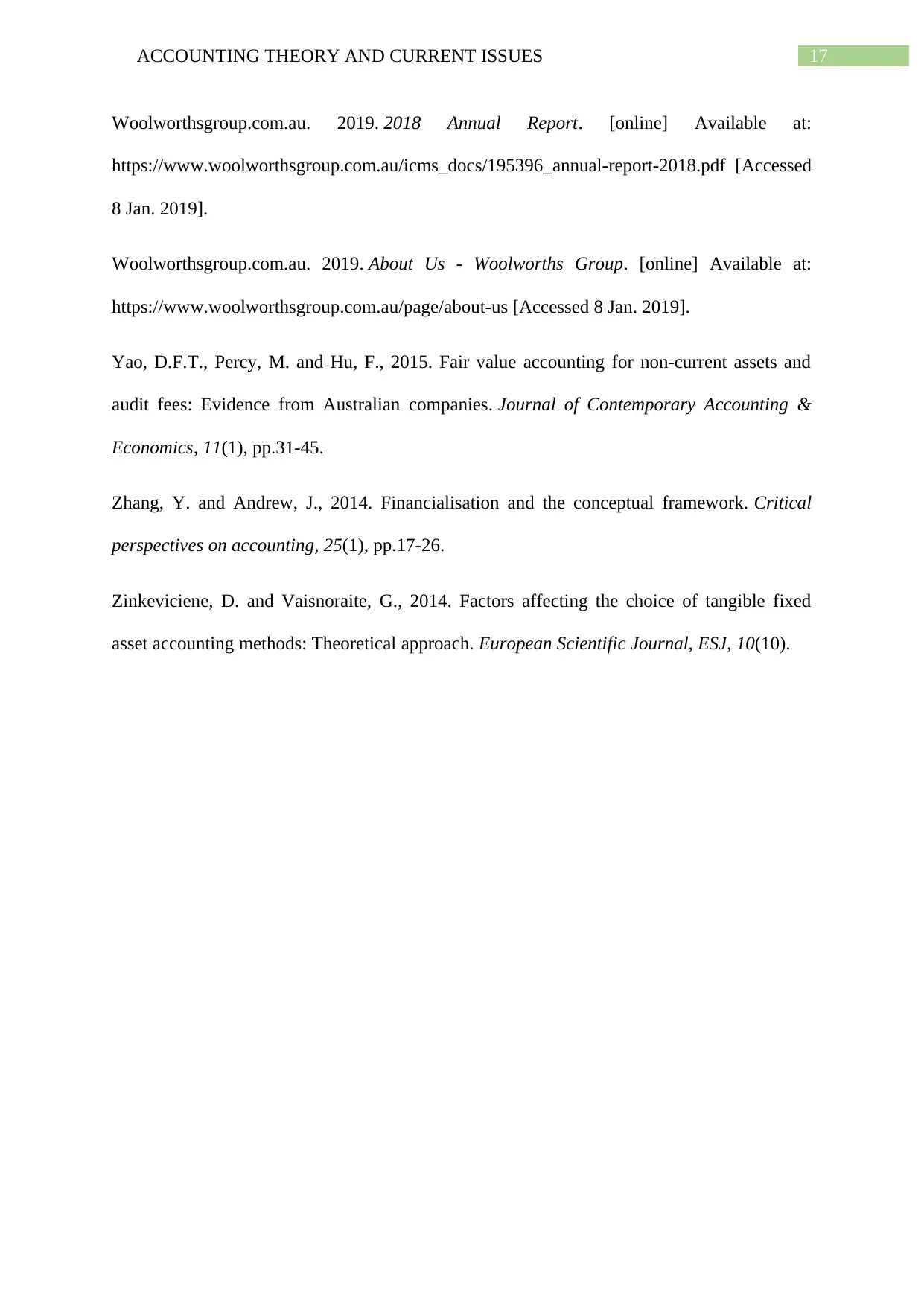
17ACCOUNTING THEORY AND CURRENT ISSUES
Woolworthsgroup.com.au. 2019. 2018 Annual Report. [online] Available at:
https://www.woolworthsgroup.com.au/icms_docs/195396_annual-report-2018.pdf [Accessed
8 Jan. 2019].
Woolworthsgroup.com.au. 2019. About Us - Woolworths Group. [online] Available at:
https://www.woolworthsgroup.com.au/page/about-us [Accessed 8 Jan. 2019].
Yao, D.F.T., Percy, M. and Hu, F., 2015. Fair value accounting for non-current assets and
audit fees: Evidence from Australian companies. Journal of Contemporary Accounting &
Economics, 11(1), pp.31-45.
Zhang, Y. and Andrew, J., 2014. Financialisation and the conceptual framework. Critical
perspectives on accounting, 25(1), pp.17-26.
Zinkeviciene, D. and Vaisnoraite, G., 2014. Factors affecting the choice of tangible fixed
asset accounting methods: Theoretical approach. European Scientific Journal, ESJ, 10(10).
Woolworthsgroup.com.au. 2019. 2018 Annual Report. [online] Available at:
https://www.woolworthsgroup.com.au/icms_docs/195396_annual-report-2018.pdf [Accessed
8 Jan. 2019].
Woolworthsgroup.com.au. 2019. About Us - Woolworths Group. [online] Available at:
https://www.woolworthsgroup.com.au/page/about-us [Accessed 8 Jan. 2019].
Yao, D.F.T., Percy, M. and Hu, F., 2015. Fair value accounting for non-current assets and
audit fees: Evidence from Australian companies. Journal of Contemporary Accounting &
Economics, 11(1), pp.31-45.
Zhang, Y. and Andrew, J., 2014. Financialisation and the conceptual framework. Critical
perspectives on accounting, 25(1), pp.17-26.
Zinkeviciene, D. and Vaisnoraite, G., 2014. Factors affecting the choice of tangible fixed
asset accounting methods: Theoretical approach. European Scientific Journal, ESJ, 10(10).
1 out of 18
Related Documents
Your All-in-One AI-Powered Toolkit for Academic Success.
+13062052269
info@desklib.com
Available 24*7 on WhatsApp / Email
![[object Object]](/_next/static/media/star-bottom.7253800d.svg)
Unlock your academic potential
© 2024 | Zucol Services PVT LTD | All rights reserved.





